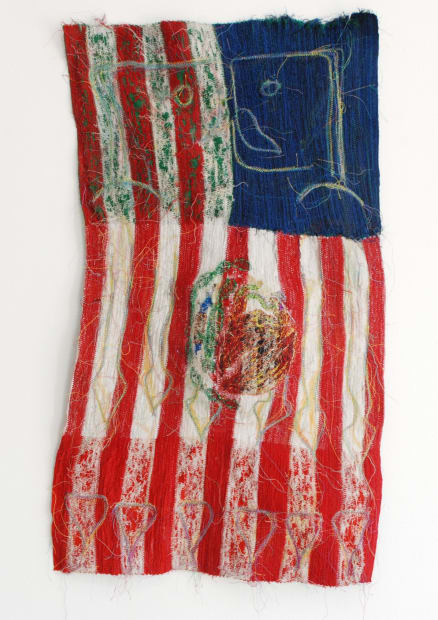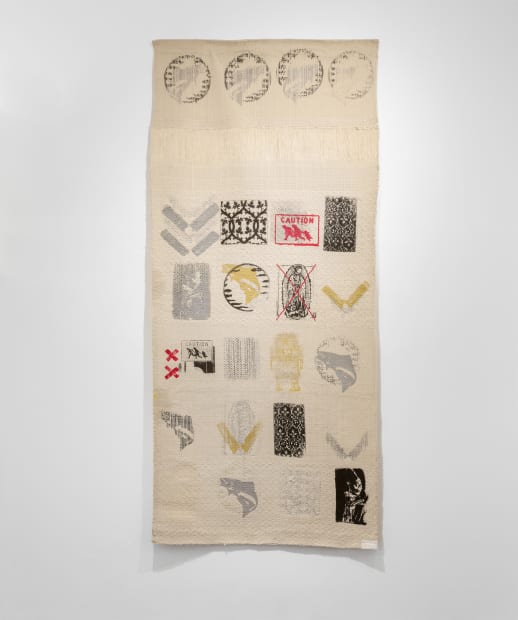-
Consuelo Jimenez Underwood: Threads from Border-landia
-
Ruiz-Healy Art is pleased to present two concurrent solo exhibitions from Consuelo Jimenez Underwood at both our San Antonio and New York City galleries. In 2022, the artist was awarded the Latinx Artist Fellowship, a first-of-its-kind initiative that recognizes 15 of the most compelling Latinx visual artists working in the United States today. The artist is also the subject of a publication, Consuelo Jimenez Underwood: Art, Weaving, Vision, a recent comprehensive analysis of her work and impact on feminist textile art history. This is the artist’s first solo exhibition with the gallery.
-
 Consuelo Jimenez UnderwoodQuatalique-Landia, 2017Nylon Mexican flag, cotton and metallic thread30 x 17.25 in
Consuelo Jimenez UnderwoodQuatalique-Landia, 2017Nylon Mexican flag, cotton and metallic thread30 x 17.25 in
76.2 x 43.815 cm -
!['[Night Lights] was for the ladies of the night. The streetwalkers, the ones that I was familiar with because of...](data:image/gif;base64,R0lGODlhAQABAIAAAAAAAP///yH5BAEAAAAALAAAAAABAAEAAAIBRAA7) Consuelo Jimenez UnderwoodNight Lights, 1991Woven, silkscreened, silk, cotton, rayon53 x 36.5 in
Consuelo Jimenez UnderwoodNight Lights, 1991Woven, silkscreened, silk, cotton, rayon53 x 36.5 in
134.6 x 92.7 cm -
 Consuelo Jimenez Underwood
Consuelo Jimenez UnderwoodVirgen de los Nopales, 2005
Stitched print on paper with cotton and synthetic threads
20 x 26 in
50.8 x 66.04 cm
Printed at Self Help Graphics
Edition of 72
-
-
 Consuelo Jimenez UnderwoodWoody, My Dad and Me, 2018Woven wire, linen, metallic and cotton thread50 x 18 in each, 50 x 54 in total
Consuelo Jimenez UnderwoodWoody, My Dad and Me, 2018Woven wire, linen, metallic and cotton thread50 x 18 in each, 50 x 54 in total
127 x 45.7 cm, 127 x 137.2 cm -
 Consuelo Jimenez UnderwoodSoaring: American Landscape, 2022Woven, linen, wire, metallic threads30.5 x 92 in
Consuelo Jimenez UnderwoodSoaring: American Landscape, 2022Woven, linen, wire, metallic threads30.5 x 92 in
77.5 x 233.7 cm -
 Consuelo Jimenez UnderwoodHiWays to Heaven, 2022Signed on back of artwork labelTapestry, metallic threads4 x 5 in
Consuelo Jimenez UnderwoodHiWays to Heaven, 2022Signed on back of artwork labelTapestry, metallic threads4 x 5 in
10.16 x 12.7 cm -
 Consuelo Jimenez UnderwoodSacred Jump, 1994Woven, silkscreened, embroidered, silk threads, barbed wire, and gold wire83 x 38 in
Consuelo Jimenez UnderwoodSacred Jump, 1994Woven, silkscreened, embroidered, silk threads, barbed wire, and gold wire83 x 38 in
210.8 x 96.5 cm -
"The American Dress triptych can certainly be seen as Jimenez Underwood intended, as a statement of deep, profound, and prideful American Indigenous identity and garments that join the lineage of sacred clothing infused with power by the intentional, painstaking labor of the maker."
-Ann Marie Leimer, "Garments for the Goddess of the Americas,"Consuelo Jimenez Underwood: Art, Weaving, Vision, Duke University Press, 2022 -
-
About the Artist
Click to learn more
Consuelo Jimenez Underwood: Threads from Border-landia: New York City
Past viewing_room



!['[Night Lights] was for the ladies of the night. The streetwalkers, the ones that I was familiar with because of...](https://artlogic-res.cloudinary.com/w_620,h_620,c_limit,f_auto,fl_lossy,q_auto/artlogicstorage/ruizhealyart/images/view/552fec7f3606875a01d38bbf85ad30e3j.jpg)










